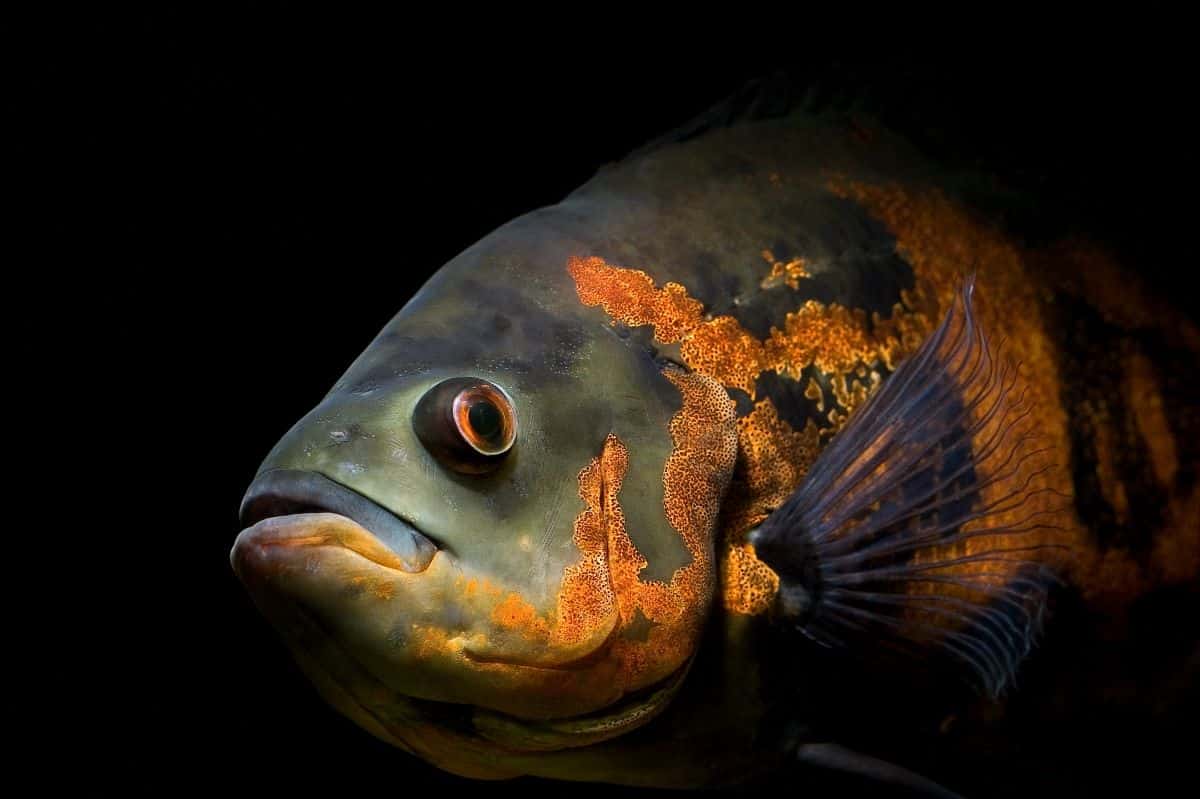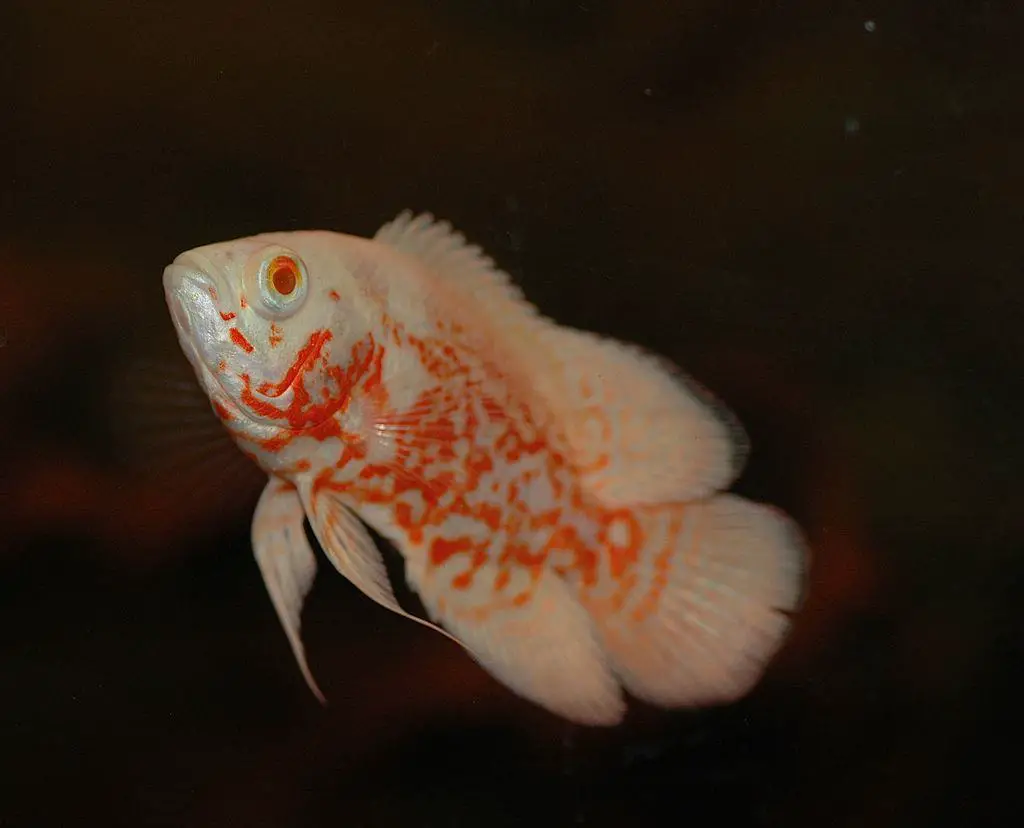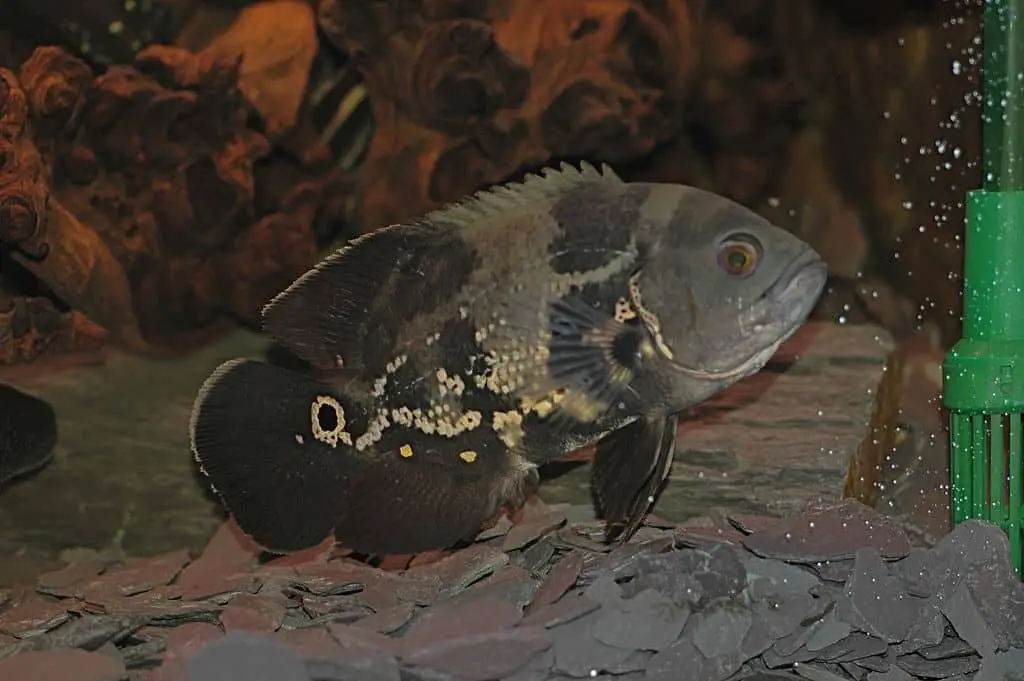I don’t know about you? But I find it very hard not to admire and want to keep these intriguing, intelligent and friendly fish. The Tiger Oscar (Astronotus Ocellatus) really are irresistible!
And that is why, I did my research, purchased some, and boy do I love them!
I now hear you asking ‘are they hard to keep?’ Well, the answer to that and many other questions are right here in this the ‘Tiger Oscar (Astronotus Ocellatus) Essential care guide.’
Table of Contents
Tiger Oscar: Species Profile
When first discovered in 1831, by Louis Agassiz, they fish was mistakenly categorized as marine. Luckily, the mistake was soon rectified, and they have been kept (correctly) as tropical water species ever since.
Popular in the USA and Europe, Tiger Oscars have impeccable memories making them capable of being taught tricks and giving them the ability to recognize their keepers. In fact, they are thought to be one of the most intelligent aquarium fish kept today.
Often referred to as river/water dogs, Tiger Oscar are also one of the most friendly fish in the hobby. Keepers often report that their Tiger Oscars will waggle their heads and bodies in their excitement to see them. The behavior we would expect to see from our pet dogs!
Care wise, these large fish and need an aquarium size to match their bulk, possibly up to 3.5lbs and 15 inch in length! They are, however, moderately hardy fish and in turn relatively easy to keep. This, alongside their beautiful coloring and markings, makes them an extremely attractive fish to keep.
| Scientific Name | Astronotus Ocellatus |
|---|---|
| Family | Cichlidae |
| Common Names | Velvet Cichlid, Marble Cichlid, Tiger Cichlid |
| Origin | Tropical South America |
| Sociability | Mildly Aggressive |
| Growth | Up to approximately 16 inch (Usually 12 inch) |
| Diet | Omnivore |
| Best Foods For Oscars | Larger Pellets, Live foods, meaty foods. |
| Minimum Tank Size | 55 gallon Minimum |
| Tank Level | Mid - Top |
| Care Level | Easy - Moderate |
| Water Parameters | 74 - 81℉ (23 - 27℃), pH 6 - 8, 5 - 20 dH |
| Breeding | Biparental Substrate Spawner. Easy in the right aquarium |
| Ideal Beginners Fish | Yes, With caution on tanks size |
| Jumpers | No, they rarely jump out of the aquarium |
| Availability | Good. Most stores sell them |
| Cost | From $8 for a small 3”- $50 for an adult. |
Tiger Oscar appearance and color
The Tiger Oscar has an oval-shaped body with thick set lips. They are distinguishable by their various colors, array of markings and large size at adulthood. Fully grown in captivity they can reach up 12 inches in length and weigh an incredible 3.5lbs. They are a true ‘monster fish’ in the aquarium world!
Color-wise there are several varieties some of which are rarer than others. The lemon Oscar, for example, with its slight orange hues on a lemon-colored body is hard to source and can cost in the region of $300. More common varieties such as the red or albino will start at around $18 per fish and are much easier to obtain. The following is a short guide to coloring available:
Tiger Oscar – A gold/orange body with black markings. Fins and tails are also black.
Albino Tiger Oscar – Pearlescent with orange markings.
Red Oscar – A vibrant red body with black markings. Fins and tails are also black.
Albino Oscar – Pearlescent with no markings.
Red Lutino Oscar – Orange with pearlescent markings.
Wild Caught Oscar – Various colorations such as black/pearl or green/black. Fins and tails are typically dark with yellow ringed spots (ocelli) on the caudal peduncle fin.
Veil Tail Oscar – Various colorations as detailed above but bred to exhibit long fins.
Not everyone is enthralled by the veil tail Tiger oscar although there is no denying they are stunning looking fish. However, they are also more delicate than their natural counterparts and great care needs to be taken of their tails which are easily damaged. Nips or bites from another Tiger Oscar with their teeth could lead to infection, illness and even death.
The main teeth of these fish are pharyngeal and set at the back of their mouths. These are used to manipulate and process prey. Tiger Oscars fish also have jaw teeth that are small and only used for grasping. They are, however, capable of giving you a nasty nip should your fingers or hand happen to get too close!

Natural Habitat
Found naturally in countries within tropical South America such as Peru, Ecuador, Colombia, Brazil, French Guyana and Suriname, Venezuela, Bolivia, Paraguay, Uruguay and Argentina. River systems such as the Amazon, Ica, Solimoes and Ucayali support them richly.
In more recent years they has also been introduced to countries such as China, Australia, and the U.S.A. This, however, was not an intentional introduction, rather it was a result of the pet industry that booms there.
Back in tropical South America Oscars prefer the slow-moving white waters in forested areas which are silt-laden. Here they can shelter under submerged branches, tree roots and marginal vegetation. Distribution of the Tiger Oscar within these waters, however, is limited due to their intolerance of cooler waters.
The lower temperature limit of 55.2℉ or 12.9℃ is best. Anything lower than this will be lethal. They still thrive well, despite this propensity, and are not featured on the IUCN Red List.B
Are they Aggressive?
Tiger oscar are a very personality-driven fish with expertise in commanding attention. Intelligent and with the ability to not only recognize but show delight at seeing their owner they are playful and have the ability to learn tricks. Knocking balls, swimming hoops and generally playing with objects are all well within their abilities.
Their strong personality means they are more aggressive than others and all are capable of being sensitive and moody. Tiger Oscars will change color when they are feeling stressed or defensive and this should be taken as a warning sign that aggression may occur. When angry they will also open its mouth as wide as it can and flare its gills in an attempt to make its head as large as possible. Keeping your hands well away when they show any sign of aggression as they will bite!
They often become ‘grumpy’ at several times including during tank maintenance, on seeing their reflection and if they feel any fish is encroaching on their territory. They are known to eat smaller tank mates, and it is advisable only to keep them with fish of a similar size. Aggression can be minimized, however, by keeping them in appropriately large sized tanks.
Kept in a good sized tank and with companions that are suitable the Tiger Oscar will love to watch day-to-day activities within its view. They are incredibly curious about the world around them.
Tiger Oscar Care Guide
The first thing you need to be aware of in the care of these cichlids is their rapid growth rate. The baby that you purchase at 1 to 2 inches long will not stay that way for long. Also known to grow at an average of around 1 inch per month and will need a minimum tank size of 100 gallons Plus, long rather than tall, from the outset. Anything smaller may cause your Tiger Oscar stress and will also be harder to maintain due to them being notoriously messy fish.
Read our article entitled – Oscar Cichlid Tank Size. We explain what size aquarium you’ll need for Juveniles and Adults.
Whilst 100 gallons is the recommended minimum it is advisable that Tiger Oscars are kept in as large a tank as you can provide. This is due to the advice that they should be kept in pairs or groups of 5 plus to lessen bullying. Housing a group together from a young age is also recommended as introducing fellow TRiger Oscars at a later time may lead to territorial disputes which will never be resolved.
Make sure any stone or rocks you add are too heavy for them to pick up. My adult fish once picked up a small rock and hit the front of the glass tank with it causing it to crack! 100 Gallons of water started to pour onto our carpet.
We use aquarium grade silicone sealer or Tank safe epoxy sticks to glue and hold rocks and decorations in place to prevent harm or danger to your fish and equipment. We have published a complete guide to aquarium glues and sealers which you may find helpful.
Essential accessories include a secure fitting lid/hood as Tiger Oscars like to jump and the last thing you want is to come home and find your beloved water dog laid on the floor! You will also need a heater sufficient for the capacity of your tank and filtration that is ideally over capacity.
For example, should you have a 60-gallon tank, filtration is recommended suitable for a 100 gallon. This is due to most American cichlid being messy fish as we have mentioned before. We have a complete review of all the best external canister filters suitable for Oscar Fish and larger aquariums.
Lighting Suggestions
Lighting wise Oscars do not require anything specialized. However, to enhance their color appearance fairly strong lighting teamed with a light colored substrate is recommended. To heighten their oxygen supply you can also add an air stone/bubbler.
Once you have the correct size tank and the correct setup, you will need to cycle your tank and achieve the water parameters and temperature that Oscars require. Tank temperature should be kept between 74 – 81℉ or 23 – 27℃ with water parameters of 6 – 8pH and 5 – 20 dH. Once cycled you can then add your fish.
Water changes
Once in their tank, the real care will begin. Frequent water changes are needed, preferably twice a week, to ensure parameters stay pristine. Most cichlids including these are incredibly sensitive to changes in their water, especially ammonia spikes and temperature increases or drops. Clean water is essential if you wish to avoid ich, dropsy, fin and tail rot. Tiger Oscars are susceptible to the aforementioned when they do not receive the correct maintenance.
In general, they are a hardy fish that rarely fall sick without avoidable cause. Bad maintenance as previously discussed is one possible reason for illness and nutritional deficiency. If not fed the correct diet are prone to suffer from hole in the head.
Hole in the head is an insurgence of holes and cavities that can develop across the entirety of your Tiger Oscars body and head. Luckily it is not hard to treat as long as you spot it early. Even better, you can avoid it all together by simply feeding the correct diet.
What do you feed a Tiger Oscar?
These wonderful cichlids are omnivores that in their natural habitat would eat small insects, crustaceans, seasonal fruit, and nuts. They have a large appetite and in captivity will eat most anything they are fed but especially love a varied diet. This love is beneficial as Oscars need a feeding regime that is varied and balanced.
The list of suitable food ranges and includes flake and pellets being easily obtained in pet stores and online shops like chewy.com and used as a staple by many keepers. Brine shrimp, bloodworm, krill, wafer foods and frozen peas are also easily available and regularly used.
Tetra Cichlid Jumbo Sticks Fish Food is perfect as they are big enough for larger Tiger Oscars and breakup slowly if first missed where they can be eaten before they harm the water quality.
Keep in mind that Tiger Oscars need a high level of vitamin C that in their natural habitat they would receive from their prey. In captivity, this is best given in the form of an algae supplement. We feed ours TetraPro Algae Wafers, they love them.
Less readily available or lesser known about suitable foods include locusts, grasshoppers, mealworms, garden worms, cockles, mussels, prawns, shrimp, tuna and beef heart. Care should be taken, however, with any meat products such as beef heart being fed to Tiger Oscars. This is because meat has high saturated fat content which when given in large doses can cause fatty liver disease.
Also not suitable in large quantities or as a main source of food are live feeder fish. Not only can these cause obesity in large quantities whilst not being nutritionally adequate, but improperly quarantined they can also carry diseases and foreign bacteria. In fact, feeder fish are the main cause of these problems in Tiger Oscar tanks.
If you choose to feed these to your fish only do so only as a treat. Suitable live feeders include goldfish, rosy red minnows, and guppies.
Breeding And Sexual Differences
It is not impossible to tell the difference between a male and a female Tiger Oscar but it is difficult. This is due to Tiger Oscars being monomorphic meaning their appearance is exactly the same. Females do, however, have an egg tube whilst males have a single sharp spike that they fertilize eggs with. These are only visible when they are mating making sexing Oscars virtually impossible except at this time.
As always there is an exception to the rule, and that is that female Tiger Oscars are occasionally smaller than males. This is not, however, a sure fire way to sex them.
If you are determined to breed Tiger Oscars, then your best chance of success is to purchase an already established mating pair. If you do not do this, there are no guarantees as to breeding and you will need to cross your fingers. This is not only due to difficulties in sexing Tiger Oscars but also due to them being extremely picky when it comes to choosing a partner. Your best chance stands in buying a group of juveniles who can grow up together and build a connection naturally. This, however, is a long-term plan as Tiger Oscars need to be mature, aged around 16 months to 2 years to breed.
It is also worth noting at this point before you start breeding that some Tiger Oscars are sterile and will never have hatching eggs.
On the bright side, it is possible to mate any color variations of Oscar together so long as they make a connection. Crossbreeding is not only acceptable but is also perfectly possible and done on a regular basis in captivity. Another plus is that once you have a mating pair, they will stay a mating pair. Oscars are one of the species of fish that develop extended pair bonding.
Once you have, hopefully, a mating pair you will more than likely find that you will need to induce them to breed. In their natural habitat Tiger Oscars only mate during the rainy season and with home tanks water parameters staying the same year round, it is difficult for them to know when to breed.
To start inducing this process you will need to perform 20 – 30% water changes every couple of days and lower the tank temperature by a couple of degrees. Lowering the temperature simulates the natural habitats changes during the rainy season and will encourage yours to look for a mate.
If you do not feel this approach is working or want to enhance your chances of success, you can also simulate rainfall into your tank. There are two ways to do this; you can pour water from a watering can into the tank for 10 to 15 minutes a day or use a spray bar. The easiest option would be to use the spray bar since most canister filters have them built in.
Hopefully, within a short time, you will notice a distinct change in their normal swimming habits. These behaviors will include chasing each other, slapping tails and lip-locking. One may also become more aggressive at this point than usual. To limit harm to either of the pair it is essential that possible mates are of a similar size and temperament.
Once mated they will look for a clean vertical or horizontal surface to spawn on. This generally occurs 2 to 3 days after they have performed the mating ritual. You can help with this search by placing upturned dinner plates into their tank which make an ideal egg-laying surface. The size of the batch will vary greatly ranging from just 100 eggs to 1000.
Fry will take up to 72 hours to hatch during which time the parents will guard them. Be warned that should the parents feel unsafe or upset by anything they may eat the eggs before they have had a chance to hatch. To avoid this, you can remove the eggs after fertilization. Before removing any eggs ensure they are light brown to tan in color.
This coloration indicates they have been fertilized whilst white eggs indicates being unfertilized.
Whilst the removal of eggs from the tank gives them a higher chance of survival it can also be more work. You will need to be prepared for the parents to vehemently defend the eggs you are trying to remove and for this to cause them stress. You will also need another tank for the eggs to go in which contains water transferred from their original tank. Close monitoring of the transferred eggs is also essential as they can develop a white cotton wool type fungus. Left with the parents this is not a problem as they will eat the fungus-infected eggs. In a separate tank you will need to remove the infected eggs or else the fungus will spread to them all.
Whether in with their parents or kept separately imminent hatching will be noticeable as the fry will become visible in their shells. For the first four days after they have hatched Tiger Oscar fry will be attached to their egg sack and will feed off it negating the need to feed them. After day four fry should be fed insofuria and baby shrimp three times a day. After every feed ensure all excess food and waste is removed.

If you have left the fry in with their parents, they should be separated and placed in their own tank when they reach an inch in length. At 2 inch they can be sold, given away or re-homed into their very own permanent tanks. Bear in mind that since successful pairings will breed for 9 to 10 years, it is not going to be feasible to keep all offspring.
Suitable Tank Mates
Due to the huge amount of water required for them to thrive and the fact that they can be territorial and aggressive the best tank mate recommendations for them are none! Tiger Oscars really are best kept in the same species only tank. However, this will not suit everyone and if you really want to have tank mates, there are some that could be suitable.
It is imperative that you only choose large fish that are passive/non-aggressive as a tankmate for an Tiger Oscar. Anything smaller than them they will eat and anything aggressive they might fight with or have trouble avoiding since they are slow swimmers. Being slow eaters they will also struggle for food supply with more aggressive fish.
Possible tankmates include Plecos, Jack Dempsey, Arowana, black convicts, Firemouths, Chocolate Cichlids, Jade Eye Cichlids, Black Banded Leporinus, Jurupari earth eaters and Blue Acaras.
The most successful of these would be bottom dwellers since Tiger Oscars favor the top and middle of their tanks. Be careful of catfish, however, as several species have spikes built into their fins. This means that should your Tiger Oscar decide to try to eat them he may have trouble expelling them if not feasible. This is due to the spikes digging into the their mouth or throat on the way back out. If not removed quickly in this situation, it will result in the death of both your catfish and Tiger Oscars.
Conclusion
There is absolutely no doubting that these fish makes a delightful addition to any tank with its friendly disposition and intelligence. They do, however, also need to be carefully thought about and researched before taking one on. Not only do these fish grow incredibly big but they are also a possible 10-20 year commitment with fairly rigid needs.
Having said that, if you are prepared for the commitment you will not find a fish as rewarding to keep as the friendly Tiger Oscar with his wagging head and tail, who is always pleased to see you. An Tiger Oscar really is a true buddy for life!
[author title=”About the Author”]

I have been working in the tropical fish industry for over 30 years now and I’m still learning. Everyday is a school day in this hobby. In my spare time I play golf very badly!


